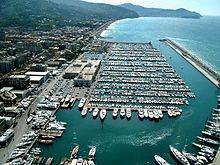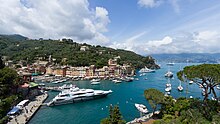Riviera di Levante (Rivëa de Levante in Liguria) is a coastal region of the Liguria.
To know
The Riviera di Levante is a stretch of Ligurian coast about 130 km long which, together with the Riviera di Ponente, makes up the Ligurian Riviera (sometimes referred to simply as Riviera).
It extends from the mouth of the Magra river in the province ofSpice up to the eastern districts of Genoa, although there is a more geographical definition that places the border between Riviera di Levante and Riviera di Ponente on the northernmost point of the Ligurian Sea, near the mouth of the Cerusa stream or the Leira stream in Voltri. Consequently, the Riviera di Levante would also include the entire municipal territory of Genoa with the exception of the hamlets Voltresi by Crevari e Vesima.
It is opposed to the Riviera di Ponente which, again conventionally, extends from Genoa (or from the mouth of the Cerusa stream) to the border French or, more correctly from a geographical point of view, up to Roccabruna (about 5 km west of Menton).
Tourism undoubtedly represents the predominant economic activity of the Riviera, thanks to the mild climate and the natural beauty of the places. In addition to purely summer tourism, dedicated to the use of beaches and coasts, we must remember the excursion and cultural tourism that is distributed throughout the months of the year, especially in places such as Five lands, Porto Venere is Portofino.
Framura, Moneglia, Montemarcello, Vernazza is Tellaro are the coastal villages of the eastern coast that are part of the list of the most beautiful villages in Italy. The tourism of families with children is also of particular importance. The transparent waters of Liguria, so full of life, are ideal for experiencing adventures with a mask and snorkel: children can enjoy swimming while observing small fish, crabs, starfish, hedgehogs and octopuses.
Geographical notes


The territory of the Riviera di Levante is almost totally hilly and mountainous, with many inaccessible areas. The only noteworthy plains are the Piana dell'Entella, behind the cities of Chiavari is Blackboard, part of the territory of Sestri Levante and the area around the mouth of the river Magra, on the border with the Tuscany.
The coastline is mostly indented and divided into inlets, bays and shelters. The main centers and the largest inlets, with sandy beaches, due to the orographic complexity of the territory, are located at the mouth of the valleys. However, this very morphological characteristic of the area makes the landscapes extremely suggestive, varied and unique in their genre, especially as regards the anthropogenic elements present.
The only islands that belong to the Riviera di Levante are the Palmaria, the Tino and the Tinetto, all forming part of the Gulf of Poets, in La Spezia.
Due to the morphological characteristics of the territory, most of the waterways of the eastern Riviera are made up of streams of limited length and flow. The only real rivers that cross this part of the region are the Vara and the Magra nel La Spezia and the Entella in the Tigullio.
Flora and fauna
The flora of the Riviera di Levante is of the Mediterranean type. Over the centuries, human intervention has led to the introduction of new species such as chestnut, stone pine and olive, the latter widely cultivated (in particular in the area of Lavagna, Sestri Levante and Moneglia) together with vine and fruit trees. Along the milder coastal strips, citrus fruits are also sporadically cultivated, especially lemon.The vegetation of the coastal woods and forests is made up of Mediterranean scrub which includes species such as broom, alaterno, mastic, myrtle, strawberry tree and the holm oak, a tree that in the past formed extensive forests. In the most arid and sun-exposed areas there is the olive tree, the carob tree and the tree spurge; there are also numerous aromatic shrubs such as thyme, bay leaf and rosemary. Along the coasts and on the hills behind there is a large number of pine forests of maritime pine and, in some areas, of Aleppo pine.
The local fauna consists of wild boar, roe deer and wolf in rare cases.
When to go
The climate of the Riviera di Levante is, as in the whole Liguria, of the Mediterranean type. Due to the conformation of the territory some areas are more sheltered from extreme weather events.
Territories and tourist destinations

The Riviera di Levante can be divided into different districts, from west to east:
- Golfo Paradiso, from Bogliasco to the Mount of Portofino
- Gulf of Tigullio, from Monte di Portofino to Sestri Levante
- Baie del Levante, from Sestri Levante to Punta Mesco
- Five lands, from Punta Mesco to the Island Palmaria
- Gulf of Poets
- Sarzanese coast, from the mouth of the Magra river to the border with the Tuscany
Urban centers
- Chiavari
- Framura
- 1 Genoa —
 Capital of the region and maritime city par excellence, heir to the maritime republic.
Capital of the region and maritime city par excellence, heir to the maritime republic. - 2 Porto Venere —

- Rapallo
- Sestri Levante
Other destinations

- Cinque Terre marine protected area - It includes the sea area between Punta Mesco to the west and Punta di Montenero to the east.
- Portofino marine protected natural area - Formed by the coast around the natural park.
- Palmaria —

- Montemarcello-Magra-Vara Regional Natural Park - On the border with Tuscany.
- Porto Venere Regional Natural Park - Includes the municipality of Porto Venere and the islands Palmaria, Tino is Tinetto.
- Portofino Regional Natural Park - It develops between the municipalities of Camogli, Portofino is Santa Margherita Ligure.
- 1 Cinque Terre National Park —
 It includes the municipalities of the Five lands and a portion of the municipalities of Levanto is Spice.
It includes the municipalities of the Five lands and a portion of the municipalities of Levanto is Spice. - Sanctuary for marine mammals (often Sanctuary of the Cetaceans) - Triangle of sea between the coasts of Tuscany, Liguria, Corsica is France.
- Tinetto —

- Tino —

How to get
By plane
In the province ofSpice, close to the border Tuscan, there is the airport of Sarzana-Luni.
By car
There are two motorways on the territory of the Eastern Riviera.
- Autostrada A12, also known as the Autostrada Azzurra, runs along the coast connecting Genoa to Livorno.
- A15 motorway, also called Autocamionale della Cisa, connects Parma to theSpice crossing the lower Taro valley, the Lunigiana and arriving in the lower Val di Magra.
The state road 1 Via Aurelia runs along the entire Riviera. In the section between Genoa and Sestri Levante it flows at sea level or, for short stretches, halfway up the coast. From Riva Trigoso up to La Spezia the road departs from the coast and climbs through the hills following the natural ups and downs of the territory. From La Spezia towards the border Tuscan resumes a flat course.

There are numerous tourist ports and hauling areas on the coasts. The main one, both in terms of trade and tourism, is undoubtedly that ofSpice. Other marinas are Porto Lotti and Porto Mirabello in La Spezia, Mouth of Magra, Lerici, Porto Venere is The Graces is Portofino.
On the train
The Riviera di Levante is crossed by the railway line Genoa-Spice, part of the Genoa-Pisa railway that from the Ligurian capital runs along the coast up to Tuscany and continue along the Tyrrhenian coast.
How to get around
By car
There are numerous provincial roads that connect the hinterland with the coastal towns, often winding or closed due to frequent landslides.
What see
What to do
At the table
Safety
Other projects
 Wikipedia contains an entry concerning Riviera di Levante
Wikipedia contains an entry concerning Riviera di Levante Wikiquote contains quotes from or about Riviera di Levante
Wikiquote contains quotes from or about Riviera di Levante Wikinews contains current news on Riviera di Levante
Wikinews contains current news on Riviera di Levante


